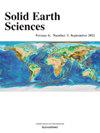地质参考物质非传统稳定同位素参考值的估算
IF 2
4区 地球科学
Q3 GEOSCIENCES, MULTIDISCIPLINARY
引用次数: 0
摘要
标准物质的均匀性及其参考值的精确性是保证非传统稳定同位素分析准确性的基本前提。然而,该领域目前在稳健的同质性评估和参考值估计协议方面存在显著的方法差距。为了解决这一差距,我们实施了一个分析框架,该框架将从地质和环境参考物质数据库(GeoReM)获取的数据与基于ISO(国际标准化组织)指南和IAG认证协议的严格质量控制措施相结合。该方法使我们能够系统地报告14个非传统稳定同位素系统和63个同位素组成。统计结果表明,大多数标准物质是均匀的。然而,我们的研究发现AGV-1和AGV-2的δ7LiLSVEC值存在显著差异,这表明它们作为Li同位素参考物质的可靠性存在潜在的局限性。此外,NIST SRM 980的Mg同位素组成表现出实质性的异质性,证实了先前的研究结果,并引起了对其适合高精度同位素测量的关注。综上所述,本研究为广泛应用的材料提供了一套全面的参考值,并建立了一套严格、标准化的评估方案。除了这些方法上的进步之外,该研究还为参考材料的选择提供了可行的建议,强调了材料均匀性和测量精度在确保同位素分析可靠性方面的关键作用。本文章由计算机程序翻译,如有差异,请以英文原文为准。
Estimation of non-traditional stable isotopes reference values for geological reference materials
The homogeneity of reference materials and the precision of their reference values are fundamental prerequisites for ensuring the accuracy of non-traditional stable isotope analysis. Nevertheless, the field currently suffers from a significant methodological gap in robust homogeneity assessment and reference value estimation protocols. To address this gap, we implemented an analytical framework that integrates data acquisition from the Geological and Environmental Reference Materials database (GeoReM) with rigorous quality control measures based on ISO (International Organization for Standardization) guidelines and the IAG Certification Protocol. This approach enabled us to systematically report the isotopic compositions of 14 non-traditional stable isotope systems along with 63 isotopic compositions. The statistical results show that most of reference materials are homogeneous. However, our investigation revealed notable difference in the δ7LiLSVEC values of AGV-1 and AGV-2, indicating potential limitations in their reliability as Li isotope reference materials. Furthermore, the Mg isotopic composition of NIST SRM 980 exhibited substantial heterogeneity, corroborating previous research findings and raising concerns about its suitability for high-precision isotopic measurements. In conclusion, this study provides a comprehensive set of reference values for widely used materials and establishing a rigorous, standardized protocol for their estimation. Beyond these methodological advancements, the study provides actionable recommendations for the selection of reference materials, underscoring the critical role of material homogeneity and measurement precision in ensuring the reliability of isotopic analyses.
求助全文
通过发布文献求助,成功后即可免费获取论文全文。
去求助
来源期刊

Solid Earth Sciences
GEOSCIENCES, MULTIDISCIPLINARY-
CiteScore
3.60
自引率
5.00%
发文量
20
审稿时长
103 days
 求助内容:
求助内容: 应助结果提醒方式:
应助结果提醒方式:


